Not too long ago, Barnes & Noble was in trouble. The rise of Amazon and the shift to e-books had the iconic bookseller closing stores and struggling to stay afloat. But fast-forward to today, and the retailer’s not just surviving but thriving, with plans to open at least 60 stores across the U.S. in 2025 alone.
So what happened? Much of it comes down to a mix of cultural shifts. Digital fatigue, post-pandemic nostalgia for in-person experiences, and demand for “third spaces” have made physical books and stores relevant again. Then, there’s the social media factor, with platforms like TikTok connecting book lovers and helping them grow into a massive community.
As social media data nerds here at Rival IQ, we couldn’t resist digging deeper into how much of an impact that online buzz really had. Let’s unpack how it all came together — and what other brands can learn from this comeback story.
The Struggle Before the Comeback
In the 2010s, Barnes & Noble seemed destined for the same fate as many brick-and-mortar retailers.
After peaking in 2008 with about 725 stores, the chain entered a decline. From 2009 onward, over 150 stores closed, and the brand was widely viewed as a relic of a pre-Amazon era. Once known as the big, bad rival of independent bookstores, Barnes & Noble suddenly became an underdog struggling to stay relevant in a rapidly digital world.
Then something shifted. Instead of dying out, the company rebounded. In 2023, the chain began to grow again, opening around 30 new stores. By 2024, that number jumped to 57, and in 2025, Barnes & Noble plans to open at least 60 more stores across 17 states.
The turnaround came from several changes, including new leadership and refreshed store designs. The biggest strategic change, though, was a stronger focus on connection and community. And in today’s world, nothing fuels that sense of community quite like social media.
Enter: BookTok
If you’ve spent any time on TikTok, you’ve probably noticed how quickly the algorithm learns what you like. Save one video about baking, and suddenly your feed is filled with pastry recipes and cake-decorating tutorials.
The same thing happened with books — and it sparked the creation of a community known as #BookTok. As of writing, the hashtag #BookTok has been used in over 63.7M posts on TikTok.
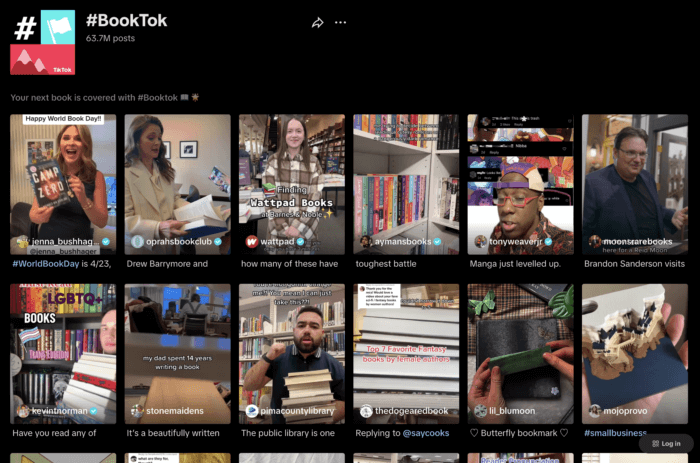
BookTok is a community of readers and creators who share recommendations, reactions, and reviews of their favorite reads. The more you like, comment, or share, the more book-related content the algorithm serves up, making it easy to feel like you’re part of a giant virtual book club.
There doesn’t seem to be any sign of slowing down either. According to Google Trends, interest in BookTok has only grown since it first popped up around June 2020.
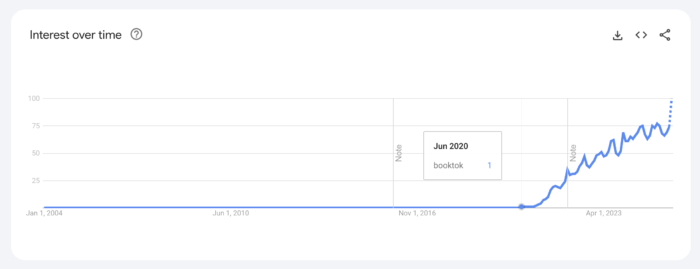
Surveys show us that the impact bleeds into real life, as well. Nearly half of TikTok users say they read more because of BookTok — 48% in the U.S., 53% in Canada — and many are reading up to 60% more books compared to before.
This shared hype has regularly turned niche titles into overnight bestsellers. In 2021, BookTok helped sell an estimated 20 million books, or over 2.4% of total book sales for the year.
For Barnes & Noble, this wasn’t just a trend to watch. It was proof that readers were still hungry for books. More importantly, it offered a clear opportunity to turn online excitement into in-store visits and growth.
How Barnes & Noble Nailed Its Social Strategy
Compared to competitors like Books-a-Million and Waterstones, B&N consistently outperforms across key metrics. In the past year, from August 28, 2024, to August 27, 2025, the brand ranked first in audience size, posting frequency, and cross-channel engagement.
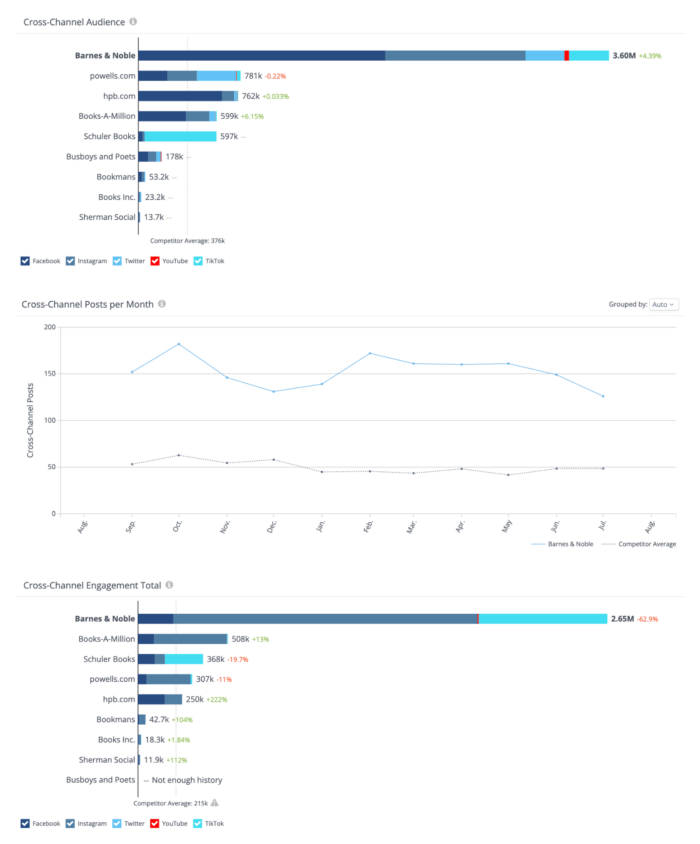
So how did they get so far ahead of the competition? With smart, deliberate moves that make their social presence feel both personal and engaging.
1. Joining Online Conversations
Barnes & Noble didn’t just watch BookTok from the sidelines — they jumped right in. The brand knew that readers weren’t just passively scrolling but actively looking for book recommendations and discussions. By tapping into this enthusiasm, B&N made itself part of the conversation, not just a retailer at the end of it.
A key move? Consistently using the #BookTok hashtag to get greater visibility and engagement within this community. And it paid off. Rival IQ’s hashtag analysis data shows that in the past year, B&N’s TikToks using #BookTok performed 1.65x better than those without it. No wonder it became their most-used hashtag (after the branded #BarnesAndNoble, of course).
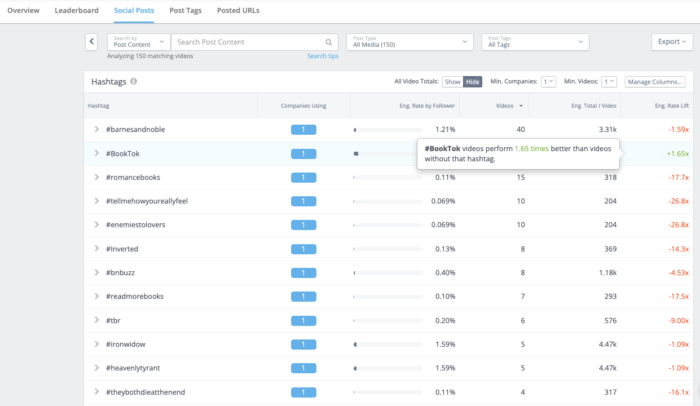
2. Bridging the Online and Physical Worlds
Another smart move that Barnes & Noble made was connecting their social media presence to the in-store experience. And that all started with a leadership approach that put local stores in the driver’s seat.
When CEO James Daunt took over in 2019, he gave individual stores more autonomy. Instead of cookie-cutter corporate setups, each location could operate like a local bookshop, tailoring displays, events, and recommendations to its community. According to Daunt, it all came down to “running really nice bookshops.”
When BookTok started blowing up, store employees who were plugged into the conversation online began reflecting it in the physical world. Tables featuring trending titles, themed displays, and staff picks started showing up in ways that directly mirrored what readers were talking about online.
Take, for example, B&N’s Instagram post featuring employee Alexis from the Clarence, NY location. Her favorite series is Throne of Glass, and she posed next to a display she likely helped set up. Fans of the series immediately chimed in, praising both the books and the location. Relatable and local, the post earned a 2.09% engagement rate by follower — 9.5x B&N’s average and 13x the retail industry median.

Barnes & Noble also hosts release parties at local stores, bridging the online and physical worlds even more. A post announcing a midnight release for the novel “Sunrise on the Reaping” earned 1.36% engagement, showing that events in real life can also drive meaningful online conversations.
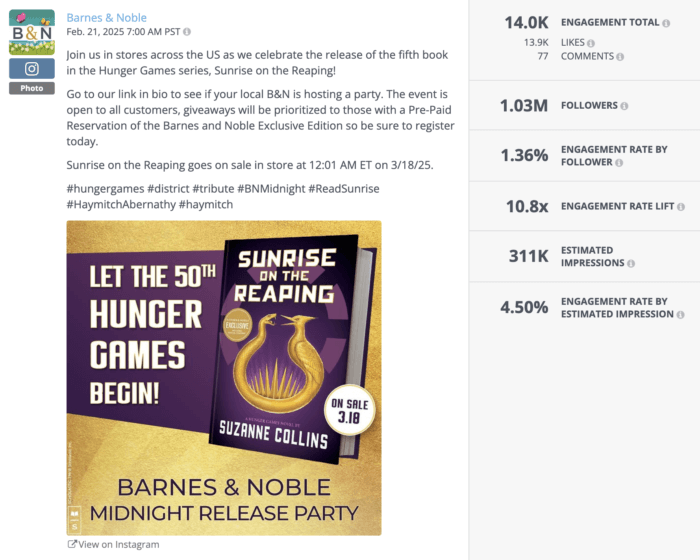
Younger audiences don’t really see a divide between online and in-person experiences. They move effortlessly between platforms and stores, expecting brands to keep up. In fact, 84% of Gen Z and millennials say they value brands that seamlessly blend technology and physical experiences. Barnes & Noble’s strategy shows one way to do that: make online conversations feel real in the aisles.
3. Tapping Into the Power of Fandom
Fandoms are everywhere — sports, music, movies, even specific book series — and they carry enormous influence online. They come with inside jokes, shared memes, and passionate communities that engage constantly.
For brands, identifying a relevant fandom and creating content that connects that community to your product can be a game-changer for visibility and engagement. Barnes & Noble knows this well, and their social strategy shows just how effective it can be.
Over the past year, the two TikToks by B&N with the highest engagement rate by follower leaned heavily into fandom culture. One featured the K-pop band Stray Kids, with the band announcing pop-up album release events at select stores. The TikTok earned a mind-blowing 38.3% engagement rate by follower — nearly 30x the retail industry median!
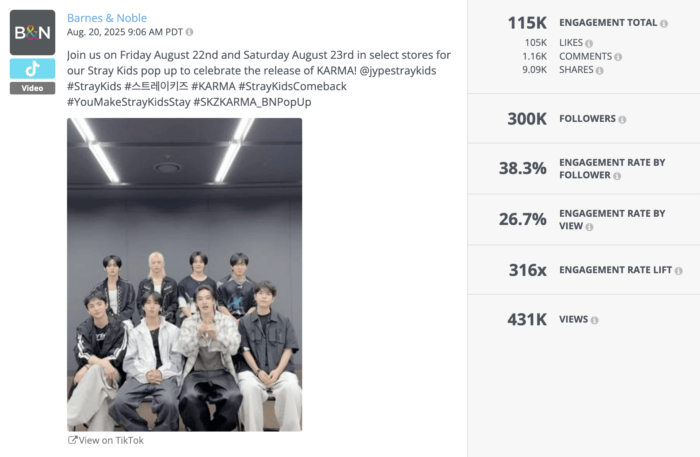
Another TikTok had an employee lip-syncing to a song from EPIC: The Musical (based on Homer’s The Odyssey) while showing off themed displays. That one earned a 30.3% engagement rate, or nearly 24x the industry median.
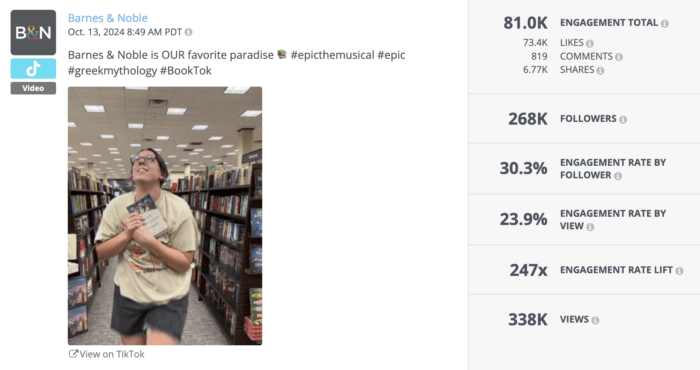
Both posts leveraged popular hashtags and topics like a beacon calling fans in — or, more likely, signaling algorithms to put the content in front of the right eyes.
Of course, you don’t want to chase every trend. Find a fandom that resonates with your brand, and create content that joins the conversation authentically. Ask local employees or listen to customers to see what’s trending in their community and let their insights guide your content. Fandoms appreciate it when a brand speaks their language, and when you do it right, the engagement can be off the charts.
4. Showing Appreciation With Giveaways
A big part of building a thriving community is showing love to your followers and customers — and giveaways are one of the best ways to do it.
Barnes & Noble nailed this in January 2025 when they hit one million followers on Instagram. To celebrate, they hosted a massive giveaway, and the results were impressive: 8.66% engagement rate and 37K comments from users tagging their friends, instantly boosting reach and drawing new eyes to the brand.
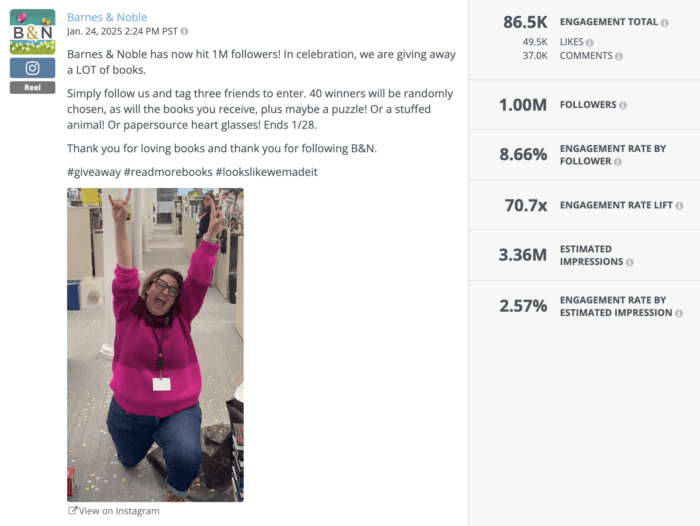
With Rival IQ’s social post analysis, we were able to see how giveaways clearly resonated with B&N’s audience. When analyzing popular topics, terms like “giving away,” “free LEGO,” “exclusive editions,” and “gift card” were among those that drove the highest engagement rates. In other words, when B&N’s posts promised a little extra love, fans responded in a big way.
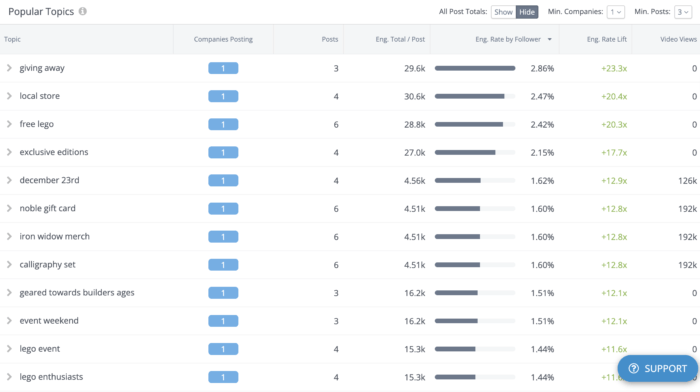
Pro tip: If you want to dig deeper, check out our blog on whether social media contests still work in 2025, which explains how to measure effectiveness and ensure your giveaways are worth the effort.
Wrapping It Up
Barnes & Noble has shown how, with the right mix of cultural awareness, community engagement, and smart social strategy, even a legacy brand can feel new again. And while their story is inspiring, it’s also full of actionable takeaways — the kind you can uncover with the right data.
We pulled all the insights above using Rival IQ, from hashtag performance to engagement spikes around fandoms and giveaways. Want to see what’s driving your own social success (and how you stack up against the competition)? Our platform makes it easy. Reach out for a free trial today.
